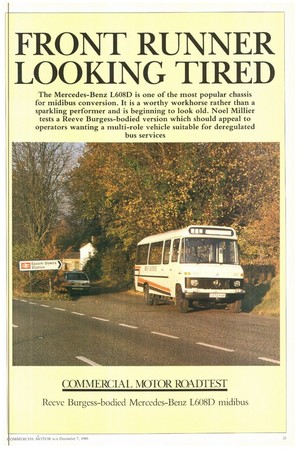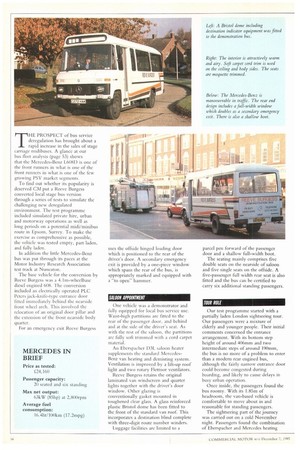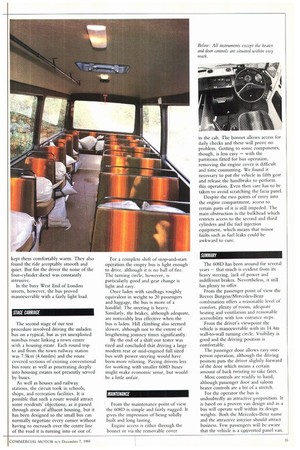FRONT RUNNER LOOKING TIRED
Page 35

Page 36

Page 37

If you've noticed an error in this article please click here to report it so we can fix it.
The Mercedes-Benz L608D is one of the most popular chassis for midibus conversion. It is a worthy workhorse rather than a sparkling performer and is beginning to look old. Noel Millier tests a Reeve Burgess-bodied version which should appeal to operators wanting a multi-role vehicle suitable for deregulated bus services
THE PROSPECT of bus service deregulation has brought about a rapid increase in the sales of stage carriage midibuses. A glance at our bus fleet analysis (page 53) shows that the Mercedes-Benz L6081) is one of the front runners in what is one of the front runners in what is one of the few growing PSV market segments.
To find out whether its popularity is deserved CM put a Reeve Burgess converted local stage bus version through a series of tests to simulate the challenging new deregulated environment. The test programme included simulated private hire, urban and motorway operations as well as long periods on a potential midi/minibus route in Epsom, Surrey. To make the exercise as comprehensive as possible, the vehicle was tested empty, part laden, and fully laden.
In addition the little Mercedes-Benz bus was put through its paces at the Motor Industry Research Association test track at Nuneaton.
The base vehicle for the conversion by Reeve Burgess was a 4.1m-wheelbase diesel engined 608. The conversion included an electrically operated PLC Peters jack-knife-type entrance door fitted immediately behind the nearside front wheel arch. This involved the relocation of an original door pillar and the extension of the front nearside body quarter.
For an emergency exit Reeve Burgess
uses the offside hinged loading door which is positioned to the rear of the driver's door. A secondary emergency exit is provided by a one-piece window which spans the rear of the bus, is appropriately marked and equipped with a "to open" hammer.
SALOON APPOINTMENT One vehicle was a demonstrator and fully equipped for local bus service use. Waist-high partitions are fitted to the rear of the passenger door, and behind and at the side of the driver's seat. As with the rest of the saloon, the partitions are fully soft trimmed with a cord carpet material.
An Eherspacher 1)3L saloon heater supplements the standard MercedesBenz van heating and demisting system. Ventilation is improved by a lift-up roof light and two rotary Flettnor ventilators.
Reeve Burgess retains the original laminated van windscreen and quarter lights together with the driver's door window. Other glazing is conventionally gasket mounted in toughened clear glass. A glass reinforced plastic Bristol dome has been fitted to the front of the standard van roof. This incorporates a destination blind complete with three-digit route number winders.
Luggage facilities are limited to a parcel pen forward of the passenger door and a shallow full-width boot.
The seating mainly comprises five double seats on the nearside of saloon and five single seats on the offside. A five-passenger full width rear scat is also fitted and the bus can he certified to carry six additional standing passengers.
TOUR ROLE
Our test programme started with a partially laden London sightseeing tour. Our passengers were a mixture of elderly and younger people. Their initial comments concerned the entrance arrangement. With its bottom step height of around 406mm and two intermediate steps of around 190mm, the bus is no more of a problem to enter than a modern rear engined bus, although the fairly narrow entrance door could become congested during boarding, and likely to cause delays in busy urban operation.
Once inside, the passengers found the bus roomy. With its 1.85m of headroom, the van-based vehicle is comfortable to move about in and reasonable for standing passengers.
The sightseeing part of the journey was carried out on a cold November night. Passengers found the combination of Eberspacher and Mercedes heating kept them comfortably warm. They also found the ride acceptably smooth and quiet. But for the driver the noise of the four-cylinder diesel was constantly intrusive.
In the busy West End of London streets, however, the bus proved manoeuvrable with a fairly light load.
STAGE CARRIAGE The second stage of our test procedure involved driving the unladen bus on a typical, but as yet unexploited minibus route linking a town centre with a housing estate. Each round trip to and from the town railway station was 7.5km (4.6miles) and the route covered sections of existing conventional bus route as well as penetrating deeply into housing estates not presently served by buses.
As well as houses and railway stations, the circuit took in schools, shops, and recreation facilities. It is possible that such a route would attract some residents' objections, as it passed through areas of affluent housing, but it has been designed so the small bus can normally negotiate every corner without having to encroach over the centre line of the road it is turning into or out of. For a complete shift of stop-and-start operation the empty bus is light enough to drive, although it is no ball of fire. The turning circle, however, is particularly good and gear change is light and easy.
Once laden with sandbags roughly equivalent in weight to 20 passengers and luggage, the bus is more of a handful. The steering is heavy. Similarly, the brakes, although adequate, are noticeably less effective when the bus is laden. Hill climliing also seemed slower, although not to the extent of lengthening journey times significantly.
By the end of a shift l our tester was tired and concluded thit driving a large modern rear or mid-engined full sized bus with power steering would have been more relaxing. Paying drivers less for working with smaller 608D buses might make economic sense, but would be a little unfair.
MAINTENANCE From the maintenance point of view the 6081) is simple and fairly rugged. It gives the impression of being solidly built and long lasting.
Engine access is either through the bonnet or via the removable cover in the cab. The bonnet allows access for daily checks and these will prove no problem. Getting to some components, though, is less easy — with the partitions fitted for bus operation, removing the engine cover is difficult and time consuming. We found it necessary to put the vehicle in fifth gear and release the handbrake to perform this operation. Even then care has to be taken to avoid scratching the facia panel.
Despite the two points of entry into the engine compartment, access to certain parts of it is still impeded. The main obstruction is the bulkhead which restricts access to the second and third cylinders and the fuel injection equipment, which means that minor faults such as fuel leaks could be awkward to cure.
SUMMARY The 608D has been around for several years — that much is evident from its heavy steering, lack of power and indifferent brakes. Nevertheless, it still has plenty to offer.
From the passenger point of view the Reeves Burgess/Mercedes-Benz combination offers a reasonable level of comfort, plenty of room, adequate heating and ventilation and reasonable accessibility with low entrance steps.
From the driver's viewpoint the vehicle is manoeuvrable with its 14.4m wall-to-wall turning circle. Visibility is good and the driving position is comfortable.
The passenger door allows easy oneperson operation, although the driving position puts the driver slightly forward of the door which means a certain amount of back twisting to take fares.
Most controls are readily to hand, although passenger door and saloon heater controls are a bit of a stretch.
For the operator the bus is undoubtedly an attractive proposition. It is based on a proven van design and as a bus will operate well within its design weights. Both the Mercedes-Benz name and the attractive interior should attract business. Few passengers will be aware that the vehicle is a converted panel van.




































































































